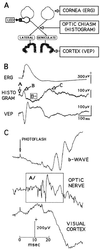Temporal distribution of the ganglion cell volleys in the normal rat optic nerve
- PMID: 11078526
- PMCID: PMC27245
- DOI: 10.1073/pnas.240448697
Temporal distribution of the ganglion cell volleys in the normal rat optic nerve
Abstract
We describe experiments on behaving rats with electrodes implanted on the cornea, in the optic chiasm, and on the visual cortex; in addition, two red light-emitting diodes (LED) are permanently attached to the skull over the left eye. Recordings timelocked to the LED flashes reveal both the local events at each electrode site and the orderly transfer of visual information from retina to cortex. The major finding is that every stimulus, regardless of its luminance, duration, or the state of retinal light adaptation, elicits an optic nerve volley with a latency of about 10 ms and a duration of about 300 ms. This phenomenon has not been reported previously, so far as we are aware. We conclude that the retina, which originates from the forebrain of the developing embryo, behaves like a typical brain structure: it translates, within a few hundred milliseconds, the chemical information in each pattern of bleached photoreceptors into a corresponding pattern of ganglion cell neuronal information that leaves via the optic nerve. The attributes of each rat ganglion cell appear to include whether the retinal neuropile calls on it to leave after a stimulus and, if so when, within a 300-ms poststimulus epoch. The resulting retinal analysis of the scene, on arrival at the cortical level, is presumed to participate importantly in the creation of visual perceptual experiences.
Figures





References
Publication types
MeSH terms
LinkOut - more resources
Full Text Sources

